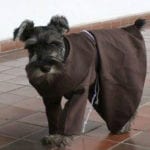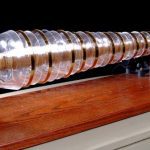 Music
Music  Music
Music  History
History 10 Less Than Jolly Events That Occurred on December 25
 Weird Stuff
Weird Stuff 10 Funny Ways That Researchers Overthink Christmas
 Politics
Politics 10 Political Scandals That Sent Crowds Into the Streets
 Weird Stuff
Weird Stuff Ten Bizarre Facts About The Doge Meme
 Our World
Our World 10 Ways Your Christmas Tree Is More Lit Than You Think
 Movies and TV
Movies and TV The 10 Coolest Stars to Set Sail on The Love Boat
 History
History 10 Things You Didn’t Know About the American National Anthem
 Technology
Technology Top 10 Everyday Tech Buzzwords That Hide a Darker Past
 Humans
Humans 10 Everyday Human Behaviors That Are Actually Survival Instincts
 Music
Music 10 Surprising Origin Stories of Your Favorite Holiday Songs
 History
History 10 Less Than Jolly Events That Occurred on December 25
 Weird Stuff
Weird Stuff 10 Funny Ways That Researchers Overthink Christmas
Who's Behind Listverse?

Jamie Frater
Head Editor
Jamie founded Listverse due to an insatiable desire to share fascinating, obscure, and bizarre facts. He has been a guest speaker on numerous national radio and television stations and is a five time published author.
More About Us Politics
Politics 10 Political Scandals That Sent Crowds Into the Streets
 Weird Stuff
Weird Stuff Ten Bizarre Facts About The Doge Meme
 Our World
Our World 10 Ways Your Christmas Tree Is More Lit Than You Think
 Movies and TV
Movies and TV The 10 Coolest Stars to Set Sail on The Love Boat
 History
History 10 Things You Didn’t Know About the American National Anthem
 Technology
Technology Top 10 Everyday Tech Buzzwords That Hide a Darker Past
 Humans
Humans 10 Everyday Human Behaviors That Are Actually Survival Instincts
10 Unusual Art Installations That Prove Art Is in the Eye of the Beholder
Art shares similarities with pizza toppings—individual preferences abound, and occasionally, the more unique choices hold the greatest allure. Within modern art, certain installations push the boundaries of our perception, igniting dialogues and evoking bewilderment. Ranging from immense rubber duck sculptures to fragments of abandoned automobiles, these ten atypical art installations underscore the truth that the perception of art is a subjective experience.
Related: 10 Rare Discoveries About Famous Artists And Their Art
10 Rubber Duck by Florentijn Hofman
Location: Various locations
Installation Type: Inflatable Sculpture
Imagine taking a leisurely walk along a waterfront, with the gentle lull of waves softly caressing the shoreline, creating a calming melody. Amid this setting, an unexpected yet captivating scene comes into view—a massive, vibrant yellow rubber duck gracefully floating atop the water’s surface. This imaginative masterpiece is the creation of Florentijn Hofman, a Dutch artist known for his ability to turn harbors across the globe into arenas of artistic expression.
Towering at a height of more than 50 feet (15.2 meters), this larger-than-life installation of a rubber duck has found temporary residence in some of the most iconic cities worldwide, leaving behind a trail of enchanted onlookers. From the Sydney Harbor in Australia to Los Angeles and the lively shores of Hong Kong, Hofman’s creation transcends cultural divides, tapping into the sense of wonder within each of us.
9 Carhenge by Jim Reinders
Location: Alliance, Nebraska, USA
Installation Type: Sculpture
Step aside Stonehenge and make way for the whimsical Carhenge, an artistic creation that pushes the boundaries of imagination. The mind responsible for this automotive marvel is artist Jim Reinders. He set out on a unique mission to pay a charming and eccentric tribute to the renowned English landmark.
Inspired by Stonehenge, Reinders re-envisioned its breathtaking arrangement with an automotive perspective. The outcome? A remarkable display of 38 vintage cars, each carefully spray-painted in a dignified shade of gray. They stand proudly, offering a contemporary twist on an ancient enigma.
From historians attempting to unravel concealed meanings to car enthusiasts reveling in the fusion of mechanical expertise and artistic expression, Carhenge invites people from different walks of life to discover their significance within its steel embrace.
8 A Knit Wonderland by Toshiko Horiuchi MacAdam
Location: Various locations
Installation Type: Fiber art
Playgrounds have always been associated with the sounds of laughter, the thrill of adventure, and an abundance of energy. However, a visionary artist, Toshiko Horiuchi MacAdam, has taken the idea of playgrounds to extraordinary new levels. She has created immersive and dynamic knit wonderlands that attract children and adults, offering them a limitless realm of imagination to explore.
When children step into MacAdam’s knit wonderland, they’re greeted with the opportunity to bounce on soft, springy waves of texture, navigate through tunnels woven with lively threads, and engage with shapes that blur the boundary between art and play. These installations erase the lines between artistic expression and recreational space, proving that art isn’t limited to the conventional gallery environment—it can thrive in the most unexpected places.
7 Inversion by Dan Havel and Dean Ruck
Location: Houston, Texas, USA
Installation Type: Architecture
The potential for creativity knows no bounds when considering the idea of two abandoned houses alongside one another. This intriguing task was undertaken by artists Dan Havel and Dean Ruck, who approached it with an innovative spirit that merged architecture and art to give rise to a truly captivating installation known as Inversion.
Havel and Ruck embarked on this creative journey united by a vision to turn decay into something beautiful, blurring the distinction between the ordinary and the extraordinary. The essence of the installation lies in the duo’s clever choice to carve out a transformative, tunnel-like corridor connecting both houses. This architectural marvel draws viewers into a fascinating vortex of illusion, challenging preconceived notions of space and reality.
6 Rain Room by Random International
Location: Various locations
Installation Type: Interactive
Step into a world where reality and imagination blend seamlessly—a rainstorm transforms into a captivating dance, and you come out completely dry. This remarkable magic spun by Rain Room is an astonishing installation that goes beyond traditional artistic standards. Created by the brilliant minds of Random International, an innovative art group, this installation showcases the perfect fusion of human ingenuity and state-of-the-art technology.
As you enter the mystical atmosphere of the Rain Room, a surreal feeling takes over. Picture a curtain of rain, frozen in time and space, reacting to your presence. The key lies in the complex array of sensors spread throughout the room like a digital nervous system. These sensors are finely calibrated to detect any movement, causing the rain to pause in what seems like a choreographed display of suspended droplets.
As visitors explore this rain-drenched sanctuary, they become actors in a mesmerizing show where they are both director and audience. With each gesture, a story unfolds—a narrative in which the human body acts as a brushstroke, painting the canvas of rain with imperceptible strokes of motion.
5 The Blue Trees by Konstantin Dimopoulos
Location: Various locations
Installation Type: Environmental
In a remarkable display of art’s potential for activism, Konstantin Dimopoulos has ingeniously pushed the boundaries of artistic expression. He has brought ordinary trees to life by turning them into stunning shades of blue, creating a captivating sight. This creative effort goes beyond aesthetics, as it also serves as a powerful way to draw attention to the urgent issue of deforestation.
Dimopoulos, an artist deeply dedicated to environmental causes, uses environmentally friendly blue pigments as his tools. This approach goes beyond the usual norms of art, transforming it into a living and breathing commentary on humanity’s intricate connection with the natural world. Each tree is treated with care to achieve the radiant azure shade, resulting in an almost otherworldly appearance that invites contemplation. It’s as though the trees have transcended their earthly nature, inviting viewers to ponder deeper thoughts.
Ultimately, Dimopoulos’s bold installation stands as proof of art’s adaptability and ability to shift viewpoints. As observers stand amazed by these blue-transformed trees, they come face-to-face with an undeniable reality: Art acts as a mirror that reflects diverse dimensions of perception. Its impact isn’t solely determined by the artist’s intent but also by the eyes that perceive and interpret it.
4 Area 15 by Meow Wolf
Location: Las Vegas, Nevada, USA
Installation Type: Mixed media
Area 15, located in Las Vegas, Nevada, is a captivating art installation born from the collaborative genius of a group of visionary artists, architects, and innovators. Conceived by the artistic minds at Meow Wolf, a renowned arts and entertainment collective, Area 15 pushes the boundaries of conventional art experiences.
This immersive wonderland blends the surreal with the spectacular, drawing visitors into a realm where reality and imagination intertwine. The artistic brilliance of Meow Wolf is evident in every facet of the installation, from its industrial-futuristic architecture to its interactive displays that respond to human touch and curiosity.
Inside Area 15, the artwork unfolds like a dreamscape. Gigantic kinetic sculptures share space with mind-bending digital projections, inviting guests to explore, engage, and interact. Meow Wolf’s signature flair for the uncanny and the unexpected is palpable, creating an environment that challenges perceptions and evokes wonder.
3 Shoes on the Danube Bank by Can Togay and Gyula Pauer
Location: Budapest, Hungary
Installation Type: Memorial
Art can transcend time and convey the weight of history, often serving as a tribute to the events that have shaped our world. The Shoes on the Danube Bank is a testament to this notion, encapsulating the solemn remembrance of a tragic past. Crafted by the hands of Can Togay and Gyula Pauer, this installation is not merely a collection of iron shoes but a memorial that speaks to the horrors of the Holocaust.
Set against the backdrop of the Danube River, the installation’s 60 pairs of iron shoes, designed in the style of the 1940s, bear witness to the suffering endured by the Jewish people. Each pair of shoes embodies an individual, a life unjustly taken, and a story silenced by the cruelty of genocide. The shoes on the riverbank evoke a haunting resonance, reminding us of the innocent lives brutally stripped away.
The choice of iron as the medium is symbolic, representing both the strength of the victims and the unyielding weight of their collective memory. The installation beckons viewers to reflect on the atrocities committed, encouraging an empathetic connection with the past and a commitment to ensure such horrors are never repeated.
2 Plastic Bags by Pascale Marthine Tayou
Location: Various locations
Installation Type: Mixed media
The plastic bag, both convenience and environmental recklessness, undergoes a profound transformation in the hands of artist Pascale Marthine Tayou. With a visionary touch, Tayou breathes new life into this mundane object, elevating it to thought-provoking art. His creative endeavor involves assembling thousands of discarded plastic bags to shape vibrant and monumental sculptures that defy conventional expectations.
Tayou presents a compelling commentary on the societal disconnect between our desire for ease and the growing urgency to address our ecological footprint. The plastic bags, once seen as disposable commodities, are reborn under Tayou’s artistry as powerful symbols, inviting viewers to reassess their individual and collective roles in the persistence of single-use plastics. The forms take on a vibrant and almost paradoxical beauty, drawing attention to their aesthetics and the inherent contradictions they represent.
1 Waste Not by Song Dong
Location: Various locations
Installation Type: Conceptual
Renowned Chinese artist Song Dong crafted an installation that pushes the boundaries of artistic expression by delving into the profound concepts of accumulation. Employing commonplace objects, Song Dong assembled a structure that elicits a sensation of disorder and arrangement.
Within the intricate layers of Song Dong’s creation, chaos and order engage in a dance, each element playing its role in an evolving narrative. The viewer’s senses are tantalized as they traverse the labyrinth, where mundane items find new purpose within the design. This metamorphosis invites contemplation about the transformative potential of the overlooked and discarded, casting a spotlight on the often-unnoticed beauty in the everyday.








